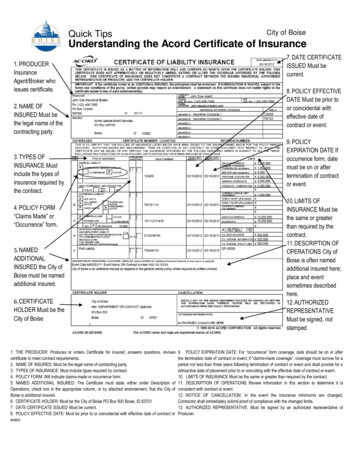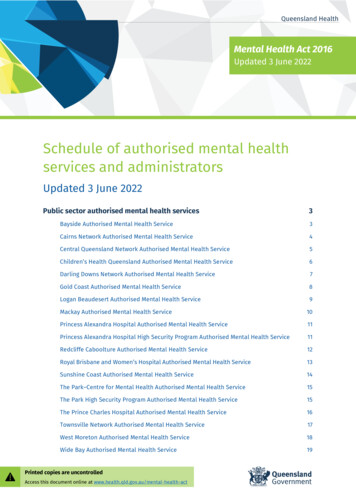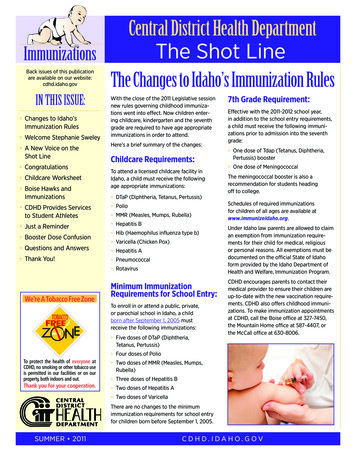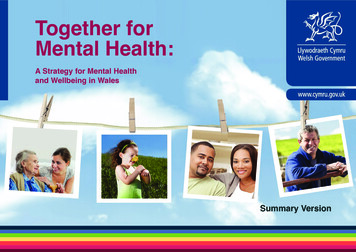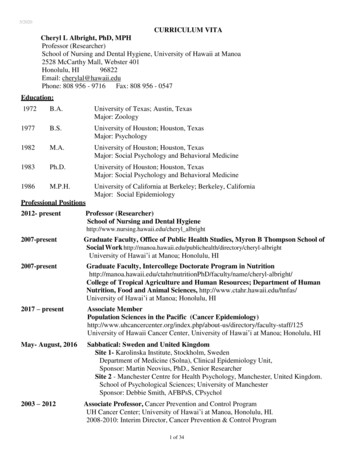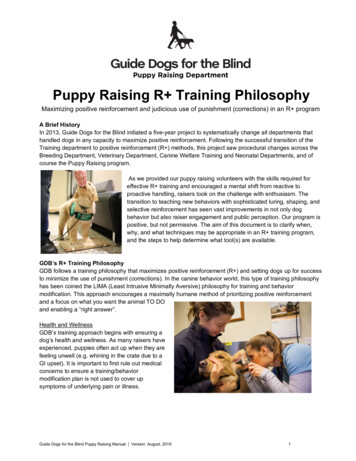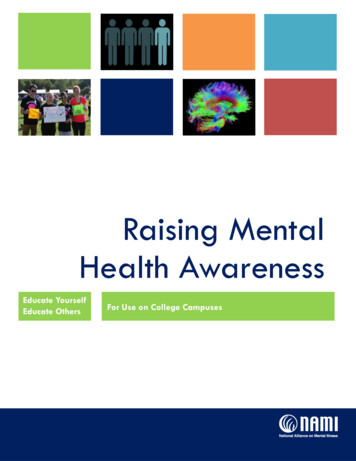
Transcription
Raising MentalHealth AwarenessEducate YourselfEducate OthersandFor Use on College CampusesRaising Mental Health Awareness - Part One: Educate Yourself1
Raising Mental Health Awareness - Educate Yourself and Educate Others 2013 by NAMI, the National Alliance on Mental IllnessWritten by Darcy Gruttadaro, Dana Crudo and Emily CeplaDesigned by Dana CrudoNAMI, the National Alliance on Mental Illness, is the nation’s largest grassroots mental healthorganization dedicated to building better lives for the millions of Americans affected by mental illness.NAMI advocates for access to services, treatment, supports and research and is steadfast in itscommitment to raising awareness and building a community of hope for all of those in need.To access this publication online, visit www.nami.org/namioncampus.Use #ItsTime on your social media pages to continue to raise the national dialogue about mental health.National Alliance on Mental Illness (NAMI)3803 N. Fairfax Dr., Suite 100Arlington, VA 22203NAMI Helpline: 1 (800) 950-NAMI (6264)Twitter: NAMICommunicateFacebook: gthofUs.orgRaising Mental Health Awareness – Educate Yourself and Educate Others2
AcknowledgementsThis presentation and guide were developed with support from the Substance Abuse and Mental HealthServices Administration (SAMHSA). The information opinion and commentary are those of NAMI and donot necessarily reflect those of SAMHSA. We greatly appreciate SAMHSA’s assistance and support.OverviewCongratulations on taking the first step to raising mental health awareness on your college campus. Thisguide provides guidance on presenting the Raising Mental Health Awareness - Educate Yourself andEducate Others presentation slides for college campuses.Your commitment to sharing important information with your campus community will make a big differencein the lives of others. Thank you for taking action.Who are we?NAMI, the National Alliance on Mental Illness, developed the presentation slides and this accompanyingguide to provide college students with important mental health information.NAMI is the nation's largest grassroots mental health organization dedicated to building better lives forthe millions of Americans affected by mental illness. NAMI advocates for access to services, treatment,supports and research and is steadfast in its commitment to raising awareness and building a communityof hope for all those in need. To learn more about NAMI, visit www.nami.org.How should you use this guide?This guide walks you through the Raising Mental Health Awareness - Educate Yourself and Educate Otherspresentation slides. It covers key points to make for each slide, suggested transitions from one slide to thenext and discussion prompt options you can choose from to engage students throughout the presentation.You should pick and choose the discussion prompts that work best in your presentation.: Try to connect the general information included in the slides and this guideto your specific school and to the students who will be attending the presentation by usinganecdotes, examples and data from your school.Who can do the presentation? Who should you par tner wit h?The slides and this guide can be used by college students, administrators, faculty, staff and other campusleaders. You may wish to partner with others in doing the presentation, although this is not required. Hereare a few people you may wish to reach out to: Your school’s health care professionals. This includes psychologists, psychiatrists, nurses, counselorsand other health care providers available on your campus who may be interested in thepresentation. College students living with a mental health condition. They can talk about their experiencesliving with a mental health condition, including the early warning signs they experienced, how andwhy they got help and what services and supports helped them the most. If your school has a NAMIon Campus club, you may want to reach out to the club to find students willing to talk about theirRaising Mental Health Awareness – Educate Yourself and Educate Others3
experiences. These personal stories can replace the videos that are currently included in thePowerPoint presentation slides. You can find a list of active NAMI on Campus clubs atwww.nami.org/namioncampus.A representative from your NAMI Affiliate. A NAMI Affiliate in your community can provideinformation on resources and help facilitate the discussion. To find contact information for your NAMIAffiliate, visit www.nami.org/local.Campus leaders. Reach out to prominent leaders on your campus, including your class president,sorority and/or fraternity advisors, popular professors, the dean of student affairs and others toreiterate that mental health issues are important and a priority on campus during the presentation.Other campus organizations and groups. You may want to include other campus organizationsand groups that can offer unique perspectives on specific issues. These can include groups thatrepresent student veterans, gay, lesbian, bisexual and transgender (GLBT) students and culturallyand racially diverse students.What should you do to prepare for the presentation?Here is a quick checklist to go through as you prepare for the presentation: Download the PDF presentation slides to your laptop. Make sure the slides display correctly andthat everything works. Make sure you have Internet connection to play the video clips linked to inthe presentation. They can all be accessed on YouTube. If you want to use different videos, makesure you have access to those videos by downloading them to your computer or finding them online.You may also want to use the Internet during the presentation to display your school’s web sectionon mental health or other resources available online. Setup a LCD projector to display the presentation. You may also want to use speakers to ensureeveryone can hear the videos. Practice the presentation to ensure you can cover all of the material within the timeframe available. You may wish to create a slide or handout that includes information about your school’s services andsupports. Handouts have also been created by NAMI and are available for your use atwww.nami.org/namioncampus. As mentioned earlier, contact anyone you may like to have present with you during the presentation. Multiply your campus population by 0.25 to determine how many college students are living with amental condition at your school. Use this number to fill in the second discussion prompt on page 6.One last note The last slide of the presentation includes a link to five short questions for students to answer about thepresentation. The link is awareness. Please encouragestudents to respond to these important questions. Their responses will help inform additional effortsrelated to college mental health. They will also help ensure that students across the country have theresources they need to make a difference and to take action on their college campuses. Thank you foryour help in collecting this important information.Guidance on the Presentation SlidesThis section outlines key points to make for each slide, discussion prompt options to encourage interactionthroughout the presentation and suggested language to transition from one slide to the next. Thispresentation assumes you have about an hour available to present the information and interact with thestudents.Raising Mental Health Awareness – Educate Yourself and Educate Others4
You should choose which discussion prompts you would like to use and have time for before doing thepresentation. It is best to go through this guide while viewing the slides to become more familiar with thepresentation.Slide 1Key Points [Introduce yourself and other presenters, if applicable. You may want to share a personal story onwhy mental health is important to you and/or why it is important to your campus community.]Thank you everyone for attending this presentation. The information you learn today can help yousave a life. You are making a valuable contribution to your campus community by attending thissession and learning more about mental health.This slide presentation was created by NAMI, the nation's largest grassroots mental healthorganization dedicated to building better lives for the millions of Americans affected by mentalillness. To learn more about NAMI, visit www.nami.org.Mental health is important to everyone and here are the reasons why.Slide 2Key Points Everyone has mental health. Mental health impacts every part of your life from academic success tosocial interactions to physical health.Feeling well makes it easier to respond to the demands and stresses of campus life. Having a healthybalance is important to feeling confident, capable and happy.Everyone needs to take care of their mental health to cope well with the highs and lows of thecollege experience. Establishing healthy habits early on makes it much easier to cope with whateverlife brings.This presentation will include more information on effective coping skills and staying mentally healthy.Mental health is also important because mental health issues are common and canimpact anyone at any time.Slide 3Key Points Everyone has mental health so this is an issue that concerns all of us.Mental health issues are common and are just like any other physical health conditions.[Read from slide].There should be no fear. Mental health is something we all deal with. It’s time to speak up and talkmore openly about it so all college students can feel more supported and more encouraged to askfor help.To help raise the national dialogue about mental health, use #ItsTime on your social media pages toencourage people to speak up.By attending this presentation, you are already having a positive impact on stigma. By educatingand informing yourselves on the facts about mental health, you are taking the first step to helpingeliminate stigma.Raising Mental Health Awareness – Educate Yourself and Educate Others5
Discussion Prompt: If one in four young adults experience a mental health issue that means (calculate .25 of yourcampus population) students on our campus have a mental health condition. What isyour reaction to mental health issues being so high?You all can help eliminate stigma and make a difference by becoming more aware ofmental health issues.Slide 4Key Points You can make a difference on campus by first educating yourselves about mental health.The first part of the presentation covers the following topics: the facts about mental health, thewarning signs of mental health conditions and what to do if you see the warning signs. The secondpart of the presentation has ideas on how you can raise mental health awareness by implementingactivities and events on campus.Thank you again for attending this presentation.We will now be delving into the facts about mental health.Slide 5This is a transition slide.Slide 6Key Points Now I am going to share a definition of mental health that comes from the Centers for DiseaseControl and Prevention (CDC) to ensure we are all on the same page.[Read the definition from the slide].Discussion Prompt: What do you think it means to be mentally healthy?Here is how other young adults defined being mentally healthy.Slide 7Key Points This is how other young adults surveyed defined being mentally healthy.[Read the responses from the slide].Raising Mental Health Awareness – Educate Yourself and Educate Others6
Now let’s define what mental health conditions are.Slide 8Key Points Here is a definition of mental health conditions from the Centers for Disease Control and Prevention(CDC) to ensure we are all on the same page.[Read the definition from the slide].Let’s see what mental health issues are most common with college students.Slide 9Key Points: Here are the percentages of mental health conditions diagnosed or treated in college students in thelast twelve months from the American College Health Association (ACHA) retrieved at www.achancha.org. ACHA surveyed over 29,000 students from 54 colleges and universities to obtain thisinformation.According to ACHA, students have cited depression and anxiety as among the top impediments toacademic performance.I will not be providing details about these mental health conditions during this presentation. However,you can access NAMI’s fact sheets on these mental health conditions in college students atwww.nami.org/namioncampus.There are several factors that can cause these common mental health conditions.Slide 10Key Points Mental health conditions are nobody’s fault, can happen to anyone and are not a sign of weakness.[Read from the slide].A family history of mood disorders (like depression and bipolar disorder) and a stressful life event inthose who are genetically vulnerable can lead to the development of a mental health condition.Some individuals develop a mental health condition as a result of a triggering event, includingextreme stress, physical or sexual trauma, alcohol or substance use, a relationship breakup, feelingsof failure or seemingly nothing at all.In college, there are high rates of academic, social and emotional stress and triggering events likealcohol and substance use—which may increase the risk of developing a mental health condition forsome students.Another fact about mental health conditions is that they are common and impactmany college students in numerous ways.Raising Mental Health Awareness – Educate Yourself and Educate Others7
Slide 11Key Points Here is a list of college stressors that may trigger mental health issues in college students.Be aware of these stressors in yourself and your friends. Take time to take care of your mentalhealth and well-being during stressful times by exercising, eating well, getting adequate andregular sleep, creating a support network and focusing on positive activities and people.There is much college students can do to reduce these stressors and positively impact the mentalhealth of their peers.We can host social events that do not serve alcohol like hiking, running, participating in creativeactivities, going to comedy shows and much more. We can promote activities that help reduce stresstoo like yoga, meditation, journaling and other relaxing activities. We can also provide importantinformation on services and supports available on campus to help manage these stressors.Most of all, we can create a safe and healthy zone where students feel comfortable talking aboutthese stressors and other mental health issues. Discussion Prompt: What do you do to manage college stress?These stressors can make some college students susceptible to mental health issues.Slide 12Key Points This is a graphical representation of the stigma that continues to exist for many young adultsdealing with mental health issues. It was created by a young adult living with a mental healthcondition.It represents the myths and stereotypes of mental health conditions that help contribute to stigma. Itshows how the young adult felt perceived by various groups of people in her social network.These myths include the perceptions that people living with mental health conditions are “crazy,”need to just “snap out of it,” are “dangerous” or “scary” or should just take medications to feelbetter.The reality is that college students experiencing mental health conditions do get better with the rightservices and supports. They are also more than their mental health condition. They are smart,friendly, talented and successful young adults who are great friends, students and communitymembers. Discussion Prompt: What myths and stereotypes do you see about mental health and what can we do to eliminatethem?As mentioned before, people living with mental health conditions can achieve greatsuccess. Here are examples of well-known people who live with a mental health condition.Raising Mental Health Awareness – Educate Yourself and Educate Others8
Slide 13Key Points Many world leaders, politicians, Nobel Prize winners, athletes, celebrities and others with mentalhealth conditions make incredibly important artistic, political and scientific contributions to society.[Pick a few celebrities from this list who are relevant to your audience and share their mental healthissues].These current, high-profile people have battled numerous mental health issues (from left to right):- Demi Lovato (actress/singer): bipolar disorder, anorexia, bulimia and cutting- Royce White (NBA player): anxiety- Patrick Kennedy (politician): bipolar disorder and addiction- Brittany Snow (actress): eating disorder and cutting- Michael Phelps (Olympic swimmer): attention-deficit/hyperactivity disorder- Pete Wentz (musician, Fall Out Boy): bipolar disorder, addiction and suicidal thoughts- Catherine Zeta-Jones (actress): bipolar disorder- Adam Levine (musician, Maroon 5): attention-deficit/hyperactivity disorder- J.K. Rowling (author): depression and suicidal thoughts- David Beckham (soccer player): obsessive-compulsive disorder- Jim Carey (actor): depressionMany of these famous individuals have found that exercise, creative outlets like music and acting andserving as spokespeople for mental health issues have made a positive impact in their lives and havehelped them manage their mental health condition successfully.As is true with celebrities, there are also many intelligent and impressive collegestudents who have experienced mental health issues.Slide 14You should test this video before the presentation to ensure it loads properly.You can access it at http://youtu.be/hQzDyzexUE8. If you would like to use a different video you canaccess similar videos of college students sharing their experiences from www.ourspace.com.es. Insteadof playing a video, you may want to consider getting a college student living with a mental healthcondition from your school to come and present his or her personal story in person.Key Points This video was made by a University of Minnesota college student who shares his personal storyacross the country to raise awareness about mental health issues to students.In this video, he describes his experience with depression and substance use and how he got help.[Play video].This video reinforces that it’s okay to ask for help and that help is available and works. It also sharesthe early warning signs of a mental health condition.Discussion Prompt: What are your reactions to the video?Raising Mental Health Awareness – Educate Yourself and Educate Others9
Now that we have seen people who live with a mental health condition, let’s recapthe facts about mental health.Slide 15Key Points This slide recaps the facts about mental health conditions that we have been discussing.[Read from the slide].Knowing and sharing these facts with others can help to reduce stigma and eliminate the myths andstereotypes that exist.Now that we know the facts about mental health conditions, let’s discuss the earlywarning signs and what to do when you see the signs.Slide 16This is a transition slide.Slides 17 & 18Key Points [Read the warning signs from the slides].Remember that some of these signs may be a result of those college stressors we talked aboutearlier. They can be a normal reaction to stressful life events like trauma, a loss or school pressure.It’s helpful to know what is going on in a person’s life along with these warning signs.The warning signs listed here can indicate the presence of mental health conditions like depression,anxiety, bipolar disorder, substance abuse disorder, ADHD or schizophrenia.Regardless, these signs indicate that help is needed to address whatever is causing them—whetherit’s stress, a serious life-changing event or the start of a mental health condition.Let’s talk a bit more about the risks associated with excessive alcohol and drug use.Slide 19Key Points [Read from the slide].For some, a period of heavy (and usually out of control) alcohol and drug use can trigger the onsetof a mental health condition that may or may not have started on its own. Methamphetamine,cocaine, hallucinogens and marijuana are common culprits, but this can happen with alcohol, opiatesand so-called club drugs (like ecstasy) as well.Some college students begin using alcohol and/or drugs after developing a mental health conditionto cope with negative and difficult feelings and thoughts.It can be hard to differentiate between social uses of alcohol and drugs and uses that areassociated with a mental health issue. You may have a sense that a friend’s use is out of control ortoo excessive.Raising Mental Health Awareness – Educate Yourself and Educate Others10
Using alcohol or drugs regularly to cope with stress or other negative feelings usually indicates thatsomething more is going on.Drinking all day and night or drinking alone can also be a sign that your friend is struggling.In addition to the warning signs for mental health conditions, it’s also important torecognize the early warning signs of suicide, which requires immediate action.Slide 20Key Points [Read from the slide].If you see these signs, you should take action immediately even if you have been sworn to secrecy.It’s important to know these signs because suicide is a real risk in college students.Slide 21Key Points Here is data on the prevalence of suicide among college students.[Read from the slide].Some of you may have already had your own experience or know of a community experience withsuicide. It is incredibly painful and has a big impact on a community.It’s important to take action to help prevent these tragedies.Here are immediate options you have if you see the early warning signs of suicide.Slide 22Key Points [Read from the slide].Remind your friend that the hotline is 100% free, anonymous and confidential. Anything they say willbe kept secret and cannot be used against them in the future.You need to take action even if you are sworn to secrecy. You can save a life. The next section of thepresentation includes a list of people you can contact if you have a concern.Discussion Prompt: Do you have any other ideas on how you can take action when you see these signs?Now let’s talk more about what you can do if you see the early warning signs ofmental health conditions or suicide.Slide 23This is a transition slide.Raising Mental Health Awareness – Educate Yourself and Educate Others11
Slide 24You should test this video before the presentation to ensure it loads properly.You can access it at http://youtu.be/W3XvhdNFpLo. If you would like to use a different video youcan access similar videos at http://harvardspeaksup.com. Instead of playing a video, you may wantto consider getting a health care professional or psychology professor from your school to come andpresent in person about this topic.Key Points This video clip was made by a psychology professor at Harvard as part of the school’s Speak Upcampaign, which aims to show young adults with mental health issues that they are not alone and thatthey should speak up if they need help.In this video clip he describes the importance of speaking up and getting help.[Play video].Discussion Prompt: What are your reactions to the video?Along the lines of speaking up, you should tell someone you trust if you haveconcerns.Slide 25Key Points If you see the early warning signs, consider involving others who can help provide the right supportand are trained on mental health issues. There are many people on campus who are available, ableand willing to help. They have the skills to deal with these issues.Here is a list of people who are trained to help address these issues. Don’t be afraid to reach out tothem and use their support.You should also consider talking to the friend you are concerned about to learn moreabout what’s happening and to provide a listening ear.Slide 26Key Points [Read from the slide].Discussion Prompt: What would you want your friends to say if they were concerned about you?Raising Mental Health Awareness – Educate Yourself and Educate Others12
Once you have talked with your friend, see if there are ways you can providesupport if they are going through a bad time.Slide 27Key Points If you find out a friend is going through a difficult time, ask how you can be supportive.Here are several questions you can ask to determine how you can be most helpful to a friend.[Read from the slide].Only offer to help if you are comfortable and able to do so without overextending yourself.Make sure to always respect a friend’s boundaries and independence. Don’t take over.Discussion Prompts: What have you found to be most helpful when you are having a hard time?These action steps are really all about being a good friend, which is the mostimportant thing you can do when you see the signs.Slide 28Key Points The most important thing you can do if you see the early warning signs is to continue being a goodfriend. Peer support is the greatest gift you can give.Feeling socially isolated or rejected can make things much worse for someone who is having a hardtime.[Read from slide].As a friend, you can also provide hope and encouragement.Slide 29Key Points You can play an important role in encouraging a friend to seek help.Remind your friend that mental health issues are common and help is available to get better.Share the resources that exist on and off campus with your friend. Here are the types of servicesand supports that exist on college campuses.[Read from the slide. If you have a slide or handout with information about your school’s availableservices and supports, share it now].Discussion Prompt: What mental health resources are valuable on or off campus?Raising Mental Health Awareness – Educate Yourself and Educate Others13
There are also a lot of resources available online.Slides 30 and 31Key Points There is a lot of information available online about mental health. Here is a list of some onlineresources that exist for college students impacted by mental health issues.- www.NAMI.org provides help to the millions of people impacted by mental health issues- Voices4Hope provides mental health resources specific to teenagers and young adults- MentalHealth.gov was created by the White House to provide information for youth and youngadults- www.ulifeline.org provides campus-specific mental health information for college students.- NIMH provides information on mental illness as well as current research in the field- StrengthofUs is a site created by and for young adults to provide support and resources There are also many places online that you can go to talk with someone who understands.- TrevorProject allows LGBT youth to text or instant message with other LGBT individuals- CrisisChat was developed by the National Suicide Prevention Lifeline for anyone going through ahard time- IMAlive is the first live online network where 100% of volunteers are trained in crisis interventionNow that you know more about mental health conditions, what can you do to raiseawareness on campus?Slide 32We are now at the second part of the presentation that covers what to do if you want to spread theword about mental health and educate the campus community about what you just learned.If this presentation inspired you to take action and begin raising mental healthawareness, here are a few places you should start.Slide 33Key Points First you’ll want to see if there are mental health awareness groups on your campus that you can join.NAMI on Campus and Active Minds have chapters all over the country, but there are also clubs thatmay be specific to your school that are already doing work to raise awareness.If there isn’t a group, or even if there is, visit the counseling center and the Dean of Students’ officeto see what resources they have that they may share. They might be thrilled to have you as an allyand willing to partner with you on future events.Discussion Prompt: Do you know of any groups or resources on campus focused on mental health?Raising Mental Health Awareness – Educate Yourself and Educate Others14
Don’t be discouraged if these resources are not readily available to you. They canbe easily created for distribution.Slide 34Key Points NAMI has created a series of fact sheets with statistics about mental health on college campuses anda fully customizable resource sheet that covers services, information and more.Be sure to include information on your counseling center, health center, student disabilities office andany hotlines that your school has for emergencies.Make a lot of copies. Check with the counseling center and Dean of Students’ office to see if theywould be willing to contribute copies in exchange for your help distributing them.Now that you have your resources, let’s talk about using them effectively.Slide 35Key Points Part of spreading the word is about knowing where you’ll be most effective.Having a presence at places where students gather will make your job easier while ensuring thatyour message is heard.Events like campus visits, orientation and move-in day are very important because families are alsopresent at these events and will want to know that their child will be taken care of when they leave.It is important to have a presence at times of high stress, like finals week, because students are oftenin need of stress relief and resources.: You might also want to hold events that will get mental health issues more attention.Slide 36Key Points Here are some ideas to help spread awareness on a larger scale.Each of these will require an organized effort, so be prepared for the event in advance.[Read the slide]Examples of positive messages for the post-it and chalking projects include:o Mental health matters. Protect yours.o No health without mental health.o You are not alone.Discussion Prompt: Do you have any other ideas about how to get the word out?Raising Mental Health Awarenes
Mental health is also important because mental health issues are common and can impact anyone at any time. Slide 3_ Key Points Everyone has mental health so this is an issue that concerns all of us. Mental health issues are common and are just like any other physical health conditions. .


